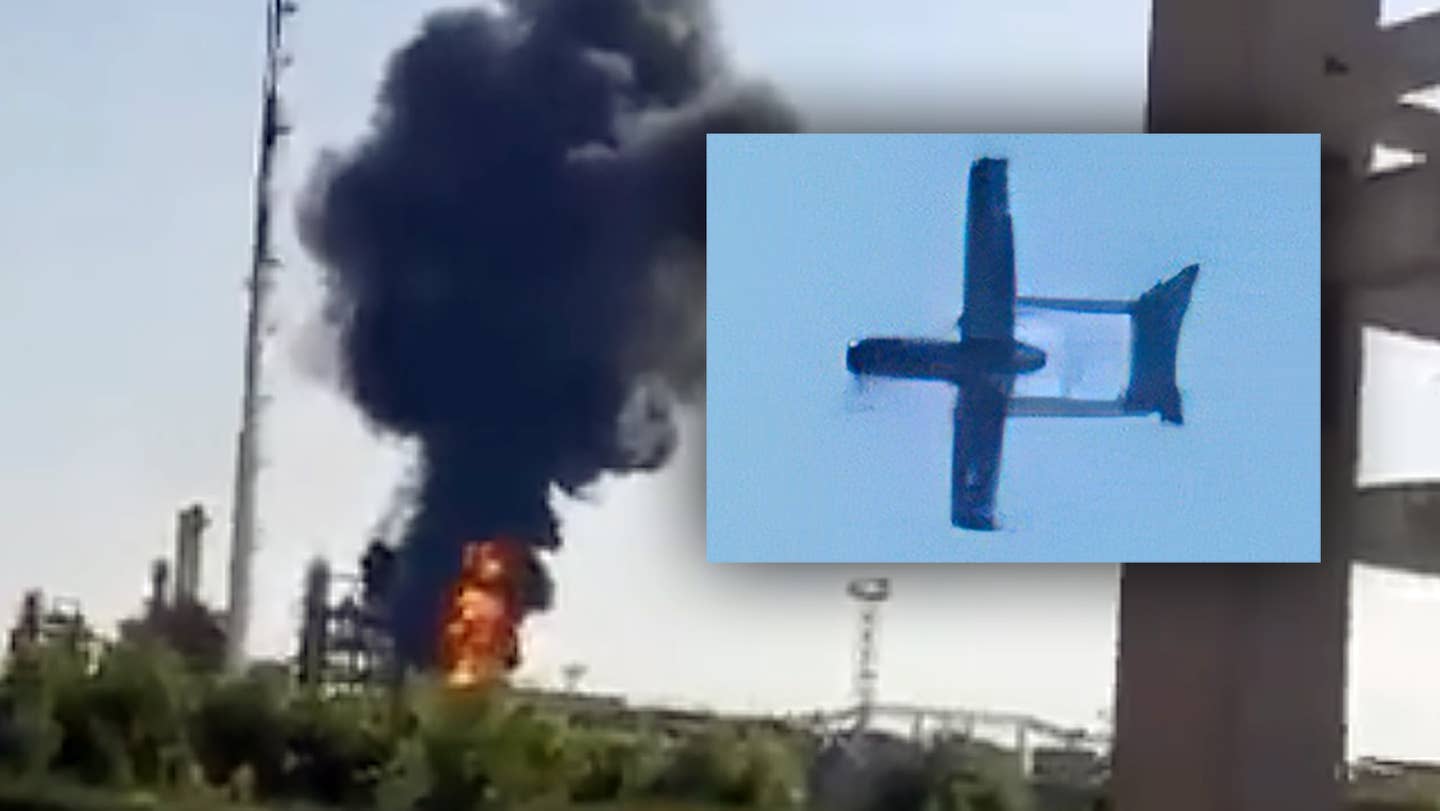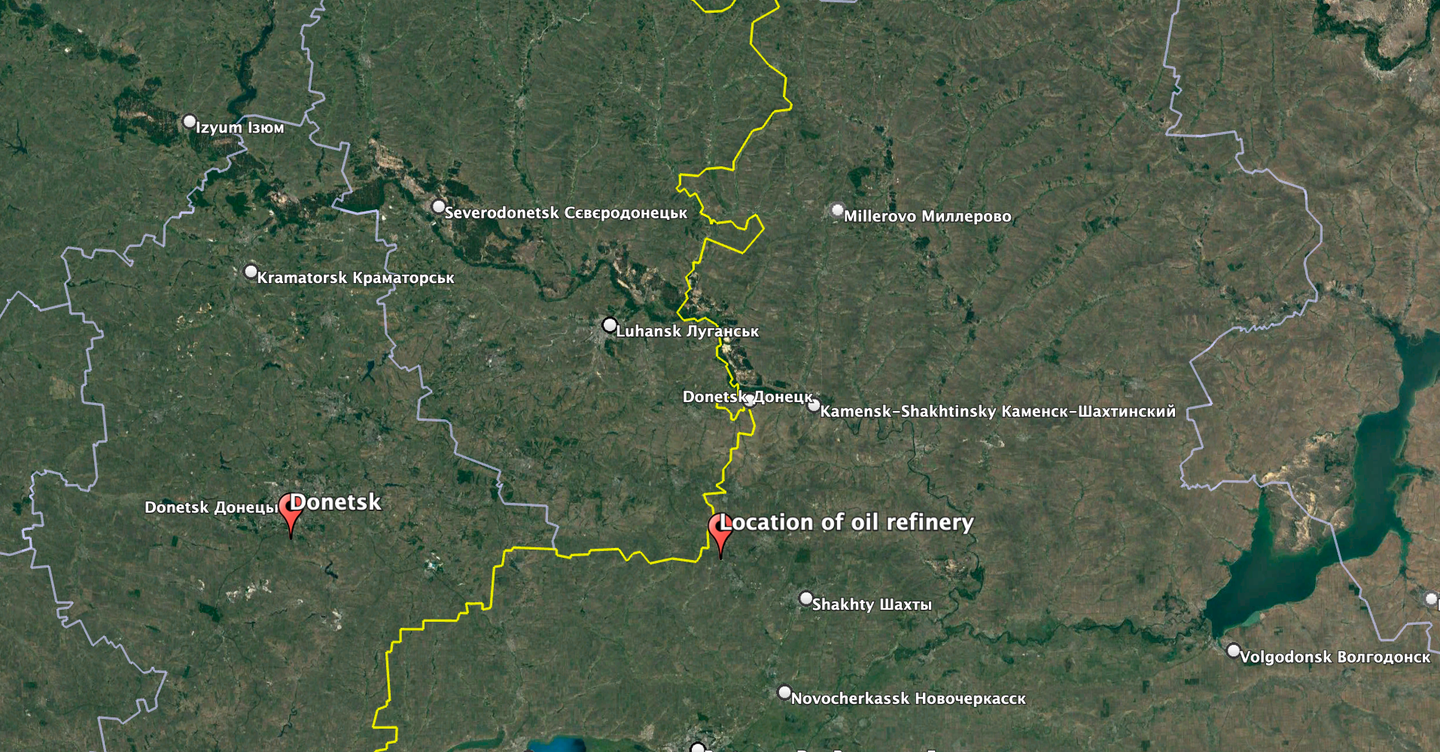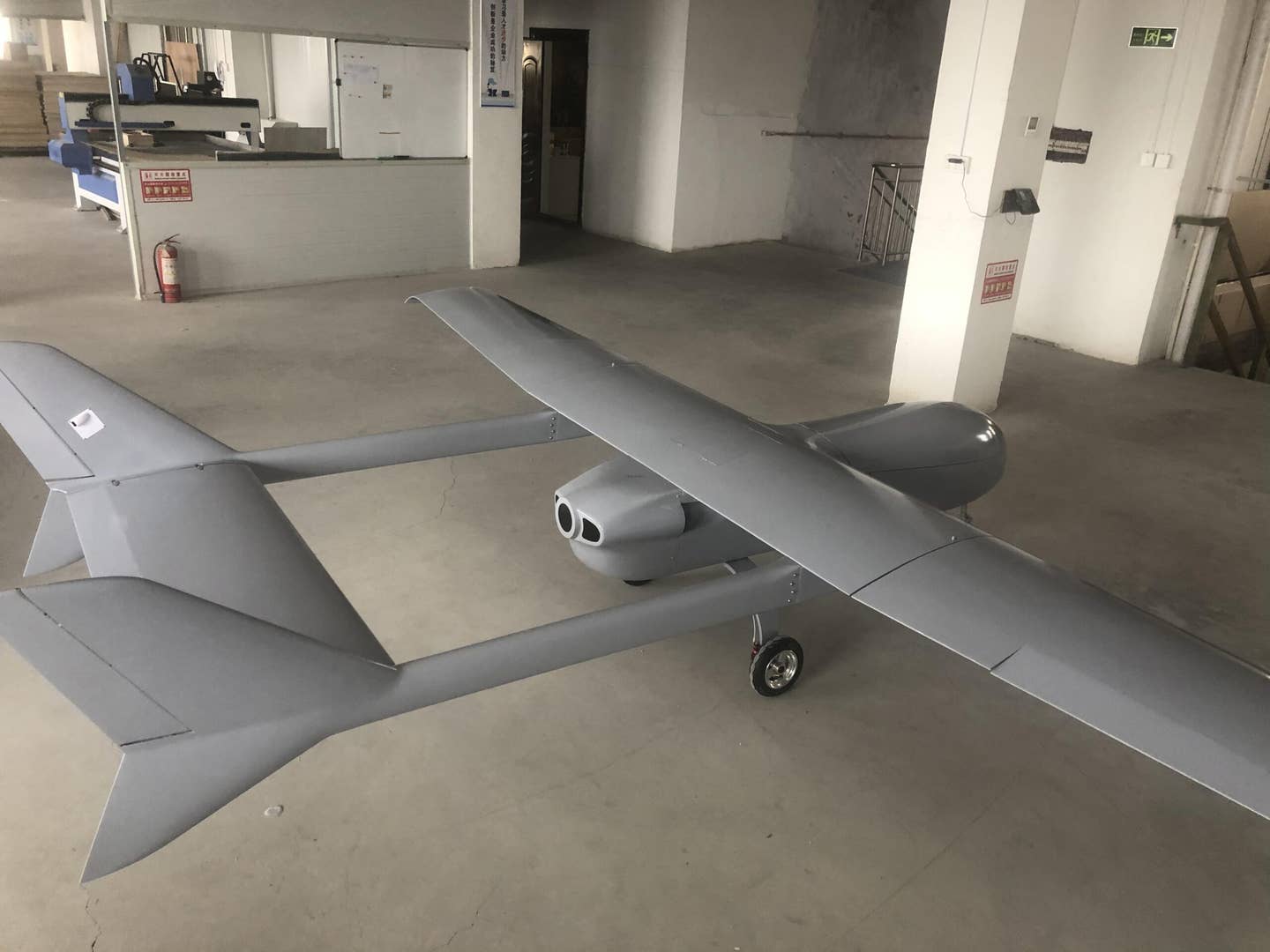THOMAS NEWDICK

Video has emerged showing a twin-boom tail configured drone crashing into a Russian oil refinery in Novoshakhtinsk, in the Rostov region, on the border with Ukraine, this morning. There is already much speculation that the incident was some kind of ‘kamikaze’ drone strike conducted by the Ukrainian Armed Forces. While the identity of the mysterious drone is yet to be established, initial analysis suggests it may have been an adapted, commercially available product that is available on the Chinese marketplace website Alibaba.
Footage of the incident apparently first appeared on the Telegram messaging service this morning before being distributed more widely across other social media channels. Filmed from nearby, the video clearly shows a twin-boom tail, pusher propeller-driven drone flying toward the refinery before making a steep dive and crashing into it, quickly resulting in a blaze.
Audio from the same sequence includes a discussion between men on the ground one of whom asks if the drone might be Ukrainian. Following the explosion, another voice can be heard over a radio transmitter saying, “The refinery has been hit. A drone dived and hit the target.”
Subsequent videos show palls of black smoke rising from where the drone hit the refinery and firefighters aiming their hoses at the flames.
In a statement, the refinery said: “As a result of terrorist actions from the Western border of the Rostov region, two unmanned aerial vehicles struck at the technological facilities of Novoshakhtinsk.” The refinery also said that staff had been evacuated and work paused while the damage was assessed.
The same statement notes that two drones were involved, the first reportedly hitting the refinery at 8:40 AM local time, followed by the second drone at 9:23 AM.
Vasily Golubev, the governor of Russia’s Rostov region, has seemingly also confirmed the incident, saying that fragments of two drones had been found at the refinery, but noting that no one had been injured.
Identifying the drone seen in the video is made more difficult since it’s not entirely clear how close to the camera it was when filmed, making it harder to gauge the size. However, the twin-boom layout is a key characteristic, as are the swept vertical fins at each end of the tailplane.
While the Ukrainian-operated, Turkish-made Bayraktar TB2 is also a twin-boom type, the drone in the Novoshakhtinsk incident appears smaller and lacks the curved intersection between the body and the leading edge of the wing, as well as its elliptical-shaped, streamlined fuselage, among other differences. As such, there has been speculation that it could have been a Ukrainian-made PD-1 or PD-2 drone, or a modification thereof. However, both the TB2 and PD series feature distinctive inverted-V-shaped tailplanes connecting the twin tubular booms. This doesn’t appear to be the case here, with the drone instead having prominent swept vertical stabilizers.
Based on its general appearance, there have been claims made that the drone might even be an example of the Russian-made Forpost, implying that Ukraine may have captured one of these and adapted it for a raid within Russian territory. While examples of the Forpost certainly have been brought down over Ukrainian territory in the past, there are also many differences compared with the drone seen in the video, including the distinctive swept tailfins, which the Forpost lacks.
As to the possibility of drones from another, Western source, Ukraine is not known to have received anything that looks remotely similar to the vehicle that we see. However, there have also been suggestions that the drone seen in the video might be some kind of commercially available product, perhaps the Skyeye 5000mm available on the Chinese Alibaba website, that was then rigged up for a ‘kamikaze’ mission by Ukrainian technicians. In particular, the shape of the tailfins on the Skyeye drone seems to tally with those of the drone in the video. The drones are selling for between $5,000 and $10,000 on the site.
One listing on Alibaba for a Skyeye 5000mm provides the following specifications:
Technical Data
Wing Span --- 5000mm
Length --- 3670mm
Length of the fuselage: 2000mm
Width of the fuselage: 375mm
Wing area --- 251.6dm2
Material --- Fiber-Glass
Max. Flying Weight --- 90kg
Twin gas Engine --- 170cc -200cc
Payload --- About 30-45 kg (with full fuel tank)
Cruising Speed --- 55km/hour.
Max Speed 150 km/hour
Empty Weight --- 30kg
Features
*Huge Payload Capability up to 20kg (with full fuel tank)
*With parachute cabin for landing *Large Air Intake & Cooling Duct for engine *Super large size cabin for FPV system
*Heavy Duty Landing gear with Steerable Nose wheel
*Detachable main wings and tail wings, easy to install and un-install, convenient for transport.
*With "H"-tail and"V" tail for option.
Equipments recommended(no included in the parcel):
Engine: 120*170CC (DLE170)
Prop:32 x10 high power wooden propeller
Servo PY-20AL x11
FUTABA3001 servo for accelerator x1
The 5000 VTOL comes with a Kevlar fuel tank. With full fuel of 27 liters, the estimated maximum flight time is over 7 hours. Its maximum take-off weight is up to 85kg and and the maximum payload is about 15 to 20kg.
This scenario actually seems much more likely. After all, while Ukraine is not previously known to have conducted this type of work, the kind of technologies involved would be well within reach of its industrial base, which already has plenty of experience with smaller drones. This would also be much cheaper and easier than acquiring and employing in-production precision-guided weapons and would also provide a significant degree of deniability.
Photos have meanwhile appeared purporting to show the wreckage of at least one of the drones around the refinery, but these fragments are too small to provide much in the way of clues to its identity.
Whatever type of unmanned aerial vehicle was used, providing this was indeed a Ukrainian ‘kamikaze’ drone strike, it marks a significant ability to target objectives within Russian territory, even if it involved a one-way mission.
Not only does the target lie on the Russian side of the border, but on the Ukrainian side is the Donbas region, including an extensive buffer zone of Russian-controlled territory that extends at least as far as Donetsk. If the attacking drones were launched from Ukrainian-held territory, it seems that, at the very least, they must have flown around 100 miles to reach their objective.
 The location of the oil refinery at Novoshakhtinsk in relation to the Ukrainian border (yellow) and Donetsk. Most of the territory east of Donetsk is held by Russian and pro-Russian forces. Google Earth
The location of the oil refinery at Novoshakhtinsk in relation to the Ukrainian border (yellow) and Donetsk. Most of the territory east of Donetsk is held by Russian and pro-Russian forces. Google EarthProviding this was a Ukrainian attack, then the Russian air defenses in the region failed to protect against it, once again calling into question their reliability, as well as pointing to the wider inability of the Russian military to establish air superiority over key parts of Ukraine including its border areas.
It is also worth noting that defending against these kinds of attacks is by no means easy, despite the relatively low speed and altitude of the drones themselves. Modern air defense systems are generally not optimized to counter these types of threats, something that Saudi Arabia, and other countries, have found out to their cost. For instance, Iran and its proxies have waged their own drone (and missile) war against Saudi oil facilities, with sometimes dramatic results. The vulnerability of this kind of infrastructure to precisely these sorts of ‘low-end’ drone attacks is a topic we have explored in the past and similar tactics employed by Ukraine could also threaten targets located much deeper within Russia, too.
What makes the apparent attack on Novoshakhtinsk especially notable is that we can clearly see one of the drones hitting a valuable infrastructure target. There have, however, been multiple previous blasts in different Russian provinces along the Ukrainian border in the last months, including reportedly on airbases and ammunition storage sites. While the cause of these previous explosions remains unclear, there has been speculation that they could have been carried out by Ukraine.
Photos have also appeared in the past showing the wreckage of TB2 drones alleged to have been taken in Russian border regions. However, it’s possible that these drones could have strayed across the border before being shot down, or crashing, and their presence in these areas alone does not amount to proof that they were responsible for any previous blasts. One of the precious (and expensive) Ukrainian TB2s is also unlikely to be used for a one-way or ‘kamikaze’ mission of the type that we have apparently seen in Novoshakhtinsk.
Wreckage of Ukrainian TB2 drones claimed shot down by Russia earlier in the conflict:
At the very start of the conflict, meanwhile, on February 24, unconfirmed reports emerged that Ukraine launched a strike against Russia’s Millerovo Air Base, less than 20 miles from the Ukrainian border. While a video showed the tail of a Russian Su-30SM Flanker multirole fighter amid the flames, the cause of this blaze remains unconfirmed to this day and it could also have been an accident.
In April, meanwhile, reports emerged that a pair of Ukrainian Mi-24 Hind attack helicopters had crossed low over the border into Russia and struck an oil storage facility in Belgorod. Once again, there is no conclusive proof that this was indeed a daring Ukrainian air raid and it’s notable that Ukrainian officials also refused to comment directly on allegations that their forces were involved. Indeed at least one Ukrainian official flatly denied their country’s involvement but, with the exception of a treasonist or rogue act, there seem to be few other explanations.
 One Skyeye 5000mm being sold on Alibaba for $6,500. Credit: Alibaba
One Skyeye 5000mm being sold on Alibaba for $6,500. Credit: AlibabaAs it stands, the lack of firm evidence and resulting confusion surrounding these various incidents on Russian soil plays squarely into the hands of the Ukrainians. As we have observed in the past, it’s arguably less important whether Kyiv was actually involved in some or all of these apparent attacks and more valuable that seeds of doubt have been sown, especially in regard to Russia’s ability to protect its own borders and the possibility of covert warfare waged by Ukraine. Should Ukraine ultimately expand drone attacks of this kind, it could also present the Russian military with a serious problem as regards relocating in-demand air defense assets to protect key infrastructure.
However, clear video evidence of at least one drone hitting an infrastructure target in Russia is a different matter, especially if Ukrainian officials acknowledge that their forces were responsible for a planned attack. At this stage, we are still awaiting official comments from Ukraine and Russia but will continue to update this story once more details emerge. Regardless, this attack reinforces the fact that we are entering a new age of warfare in which standoff weapons are available to almost anyone.
No comments:
Post a Comment